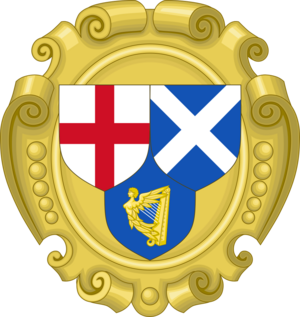Instrument of Government facts for kids
Quick facts for kids Instrument of Government |
|
|---|---|
| Original title | The Government of the Commonwealth of England, Scotland and Ireland and the Dominions thereunto belonging |
| Jurisdiction | Commonwealth of England, Scotland and Ireland
|
| Presented | 15 December 1653 |
| Date effective | 16 December 1653 Installation of the Lord Protector |
| Chambers | Unicameral (House of Commons) |
| Executive | Lord Protector, Council of State |
| First legislature | 3 September 1654 |
| Repealed | 25 May 1657 (superseded by Humble Petition and Advice) |
| Author(s) | John Lambert |
| Supersedes | Barebone's Parliament |
The Instrument of Government was a very important document in England's history. It was like a rulebook, or a constitution, for the country during a time called the Commonwealth. This was after the English Civil War when England didn't have a king.
Drafted by Major-General John Lambert in 1653, it was the first time England had a written constitution that set out how the government should work. It was a big step in how countries are governed.
Contents
Why a New Government Was Needed
Before the Instrument of Government, England had been through a long and bloody English Civil War. This war was fought between those who supported King Charles I and those who supported Parliament. After the King was defeated, people needed a new way to run the country.
Ideas for a New Government
In 1647, an earlier plan called the "Heads of Proposals" was created. This plan was meant to help set up a new government after the war. King Charles I didn't agree to it.
Later, in 1649, the Rump Parliament made a big decision. They declared that the people were the source of all power. They said that the House of Commons, chosen by the people, had the highest power in the country.
Changes After the King's Trial
Using this new idea, the Rump Parliament tried King Charles I. He was found guilty and executed. Soon after, in March 1649, Parliament passed laws to get rid of the monarchy (having a king or queen). They also abolished the House of Lords.
By May 1649, England was officially declared a Commonwealth. This meant it was a republic, governed by Parliament and its chosen officers, without a king or a House of Lords.
How the Government Worked
The Instrument of Government set up a new way to divide power in England. It created three main parts of the government:
- The Lord Protector: This person was the head of the country. It was an elected job, not passed down through family, and the person held the position for life.
- Parliament: This group made the laws. A new Parliament had to be called every three years, and each one had to meet for at least five months.
- The Council of State: This was a group of about twenty members. They advised the Lord Protector. They had strong powers, meaning the Lord Protector needed their agreement for many important actions. For example, they had to agree to use the military when Parliament wasn't meeting. They also helped choose the next Lord Protector.
Checks and Balances
The Lord Protector was not an all-powerful ruler. His powers were limited in many ways. All three parts of the government had ways to check each other's power. For instance, the Lord Protector could reject a bill from Parliament. However, if Parliament voted for the bill again with a majority after twenty days, it would still become law.
The document clearly stated that the main law-making power belonged to "one person, and the people assembled in Parliament." This person was called the Lord Protector of the Commonwealth of England, Scotland, and Ireland.
Other Important Rules
The Instrument of Government also planned for a standing army. This army would have 10,000 horsemen and dragoons, and 20,000 foot soldiers. There would also be ships to protect the seas.
The document also set rules for who could be elected to Parliament. It said that people who had supported the King (Royalists) could not be elected or vote for a time. Catholics were also not allowed to be elected or vote. To be an elector, a person needed to own property worth at least £200.
When It Was Used and Replaced
The Council of Officers officially adopted the Instrument of Government on December 15, 1653. The very next day, Oliver Cromwell became the first Lord Protector.
In January 1655, Cromwell ended the first Parliament that met under this new system. This led to a period where military generals had a lot of power.
The Instrument of Government was later replaced in May 1657. The new document was called the Humble Petition and Advice. This was England's second, and last, written constitution.
Influence on the American Constitution
Many years later, when the United States was forming its own government, some of its ideas came from earlier English documents. Since English people had already settled in places like Jamestown and Plymouth, some people in the U.S. see the Instrument of Government as part of their history. It helped shape ideas about how a country could be governed with a written constitution.
See also
- Provisions of Oxford (1258)
- The Heads of Proposals and the Putney Debates (1647)


